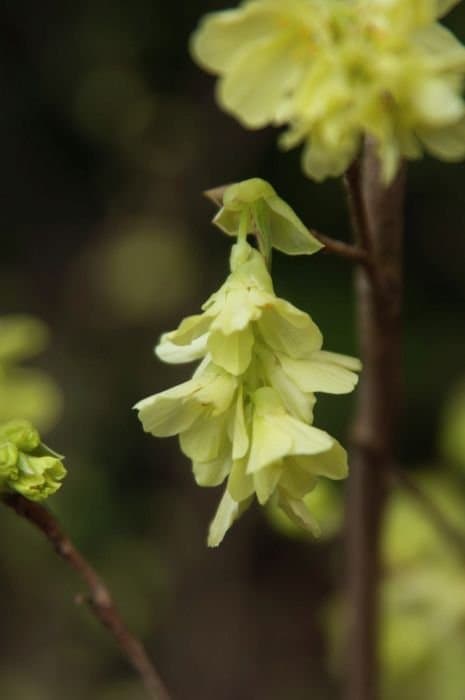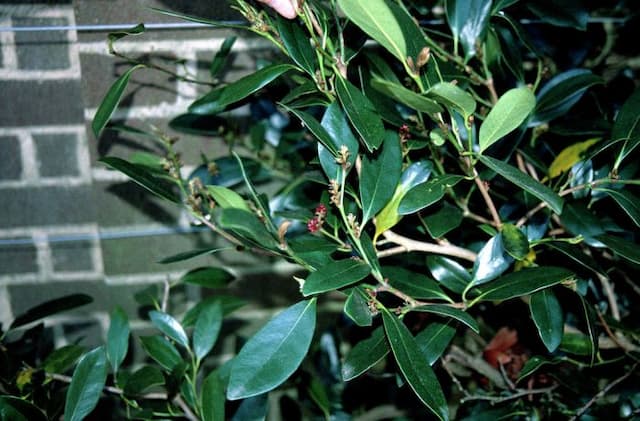Sweetgum Liquidambar styraciflua

ABOUT
The plant commonly known as Sweetgum has distinctive star-shaped leaves with five to seven pointed lobes, which change through a dazzling array of colors as seasons transition from spring to fall. Its foliage begins as a bright, glossy green, slowly morphing into brilliant shades of red, orange, yellow, and purple, making it particularly noted for its striking fall coloration. This plant also features spiky, globe-shaped fruiting balls composed of numerous capsules that persist through winter, and can often be found littering the ground beneath the tree. Its bark, gray-brown in hue, is deeply furrowed, creating a unique texture reminiscent of alligator skin. In spring, the Sweetgum produces inconspicuous flowers, which are small and not showy. The overall form of this plant is symmetrical and pyramidal, branching with a straight, central trunk that supports horizontal layers of foliage. The leaves of the Sweetgum are attached to branches by long, slender petioles, which cause them to tremble in the wind, similar to those of aspens.
About this plant
 Names
NamesFamily
Altingiaceae.
Synonyms
American Sweetgum, Sweetgum, Redgum, Satin-Walnut, Star-Leaved Gum, Alligator-Wood, Bilsted, Hazel Pine, Sycamore.
Common names
Liquidambar styraciflua var. mexicana, Liquidambar macrophylla, Liquidambar barbata.
 Toxicity
ToxicityTo humans
The Sweetgum is generally not considered toxic to humans. However, like many plants, it can be a choking hazard or cause an allergic reaction in sensitive individuals. If ingested in very large quantities, part of the plant may cause digestive discomfort, as most plant material is not meant for human consumption. There is no widespread documentation of serious poisoning from consuming Sweetgum.
To pets
Sweetgum is not commonly known to be poisonous to pets. However, ingestion of tree parts, especially the spiky seed pods, can potentially cause intestinal blockages or digestive upset in animals. Keep an eye on your pet if they ingest any part of the Sweetgum, and consult a veterinarian if you spot any unusual behavior or symptoms such as vomiting, lethargy, or loss of appetite.
 Characteristics
CharacteristicsLife cycle
Perennials
Foliage type
Deciduous
Color of leaves
Green
Height
60-70 feet (18-21 meters)
Spread
40-50 feet (12-15 meters)
Plant type
Tree
Hardiness zones
5-9
Native area
North America
Benefits
 General Benefits
General Benefits- Aesthetic Appeal: Adds visual interest to landscapes with its star-shaped leaves and bright fall coloration.
- Habitat for Wildlife: Provides food and shelter for birds and small mammals.
- Shade Provider: Creates ample shade with its dense canopy, which can help in reducing energy costs.
- Erosion Control: The extensive root system can help stabilize soil and prevent erosion.
- Resilient Growth: Adaptable to a range of soil types and conditions, making it useful for urban environments.
- Seasonal Interest: Offers year-round interest from spring flowers to autumn leaves and winter seedpods.
 Medical Properties
Medical Properties- Antibacterial: Liquidambar styraciflua has been reported to have antibacterial properties against certain strains of bacteria.
- Anti-inflammatory: The plant contains compounds that may reduce inflammation.
- Anodyne: It has been used traditionally for pain relief.
- Expectorant: The plant has been used in folk medicine as an expectorant to loosen phlegm and ease cough.
- Antiseptic: The resin is considered to have antiseptic properties.
- Astringent: The bark of the tree has been used as an astringent in traditional medicine.
 Air-purifying Qualities
Air-purifying QualitiesThis plant is not specifically known for air purifying qualities.
 Other Uses
Other Uses- Liquidambar styraciflua, commonly known as Sweetgum, has seedpods that are often used in crafting and as decorative elements in floral arrangements due to their distinctive spiky appearance.
- The wood of Sweetgum is valued for fine woodworking and furniture making, appreciated for its satiny grain pattern and ability to take on a high polish.
- Due to its straight, tall growth pattern, Sweetgum is sometimes planted as a privacy screen or windbreak in residential and rural landscapes.
- The tree's resin, sometimes called American Styrax, can be used as a natural chewing gum alternative, though less commonly in modern times.
- Sweetgum leaves, with their striking autumn colors, are often gathered for seasonal crafts and decorations, like wreaths or potpourri, especially in autumn.
- In landscaping, Sweetgum is used as a shade tree because it grows quite large and provides ample canopy coverage in parks and large gardens.
- The distinctive symmetrical shape and colorful fall foliage of the Sweetgum make it a popular choice for ornamental street planting in urban environments.
- The resin from the Sweetgum tree has historical use as an incense and was believed to have spiritual or ritual significance in some Native American cultures.
- Dried Sweetgum balls have been used in folk crafts as a natural form of pest control, thought to deter insects like spiders when placed in corners or closets.
- Sweetgum is occasionally used for the construction of small wooden items like boxes, due to its fine grain and workability.
Interesting Facts
 Feng Shui
Feng ShuiThe Sweet Gum tree is not used in Feng Shui practice.
 Zodiac Sign Compitability
Zodiac Sign CompitabilityThe Sweet Gum tree is not used in astrology practice.
 Plant Symbolism
Plant Symbolism- Change: The sweet gum tree, known for its brilliant and varying fall colors, represents the fluidity and beauty in change, reminding us that transformations can be full of beauty.
- Healing: With its storied medicinal uses, the sweet gum symbolizes healing and the utilization of natural resources for physical well-being.
- Protection: Historically, the resin-like sap (styrax) was used for various protective purposes, so the sweet gum can symbolize protection and safeguarding.
- Longevity: The sweet gum tree, which can live for a long time when not subjected to an urban environment, symbolizes endurance and perseverance.
- Adaptability: Able to thrive in a variety of climates and conditions, the sweet gum signifies adaptability and resilience in the face of life's challenges.
 Water
WaterThe Sweetgum tree should be watered deeply once a week, providing about 1.5 to 2 inches of water which equates to about 20 to 30 gallons for a mature tree. Newly planted trees require more frequent watering, about twice a week, until they are established. During periods of drought or extreme heat, the frequency may need to increase. Water should be applied slowly at the base of the tree to ensure deep soil penetration and to avoid runoff. It's important to adjust the amount and frequency of watering based on rainfall, soil type, and season.
 Light
LightSweetgum trees thrive in full sun conditions, receiving at least six hours of direct sunlight daily. The best spot for this tree is in an open area away from buildings or other structures that might cast shade. They can tolerate partial shade, but their growth may be less vigorous with reduced fall foliage color.
 Temperature
TemperatureSweetgum trees can tolerate a wide range of temperatures, from as low as 0 degrees Fahrenheit in winter to over 100 degrees Fahrenheit in summer. However, they flourish best in a temperature range between 60 and 80 degrees Fahrenheit. They're hardy in USDA zones 5 through 9, which indicates their adaptability across different climates.
 Pruning
PruningPrune the Sweetgum tree to maintain its shape and remove any damaged or diseased limbs. The best time to prune is during the dormant season, typically late winter before spring growth starts. Light pruning can be done annually, while more extensive pruning should be undertaken every 3 to 5 years to thin out the canopy and maintain tree health.
 Cleaning
CleaningNot needed
 Soil
SoilSweetgum prefers moist, well-drained acidic soil with a pH between 5.5 and 7.0. A mix of loam, compost, and pine bark would be ideal to maintain moisture and provide necessary nutrients.
 Repotting
RepottingSweetgum trees are typically not potted plants and therefore do not require regular repotting. They are large trees best suited for outdoor planting.
 Humidity & Misting
Humidity & MistingSweetgum trees are adaptable to a wide range of humidity conditions outdoors and do not require specific humidity levels for optimal growth.
 Suitable locations
Suitable locationsIndoor
Not suitable for indoor growth due to size.
Outdoor
Plant in full sun, well-draining soil; provide space for growth.
Hardiness zone
5-9 USDA
 Life cycle
Life cycleSweetgum (Liquidambar styraciflua) begins its life cycle with seed germination, which occurs after the seeds are dispersed by wind or animals, typically in spring. The seeds sprout and the seedling grows, developing a taproot and foliage, entering the juvenile stage. As it matures into the sapling phase, the sweetgum begins to establish a more extensive root system and a straight, tall trunk with star-shaped leaves. After several years, the tree reaches the adult phase, where it starts to produce its characteristic spiky fruit and can propagate through prolific seed production. The tree continues to grow in size and can live for many years, entering a mature stage with a full, broad canopy, potentially reaching over 100 feet in height. Eventually, the sweetgum enters senescence, where growth slows, and it may become more susceptible to environmental stress and disease before it dies.
 Propogation
PropogationPropogation time
Early Spring
The Liquidambar styraciflua, commonly known as the Sweetgum, is best propagated by seed. The optimal time for sowing seeds is in late winter or early spring. Seeds require stratification, which involves simulating natural winter conditions by chilling them for 1-3 months at 40 degrees Fahrenheit (4.4 degrees Celsius) before planting. After stratification, seeds can be sown in well-drained soil at a shallow depth. It's important to maintain consistent moisture until germination occurs. Once seedlings are large enough, they can be transplanted to their final location, taking care to protect them from frost and extreme heat during the establishment phase.









